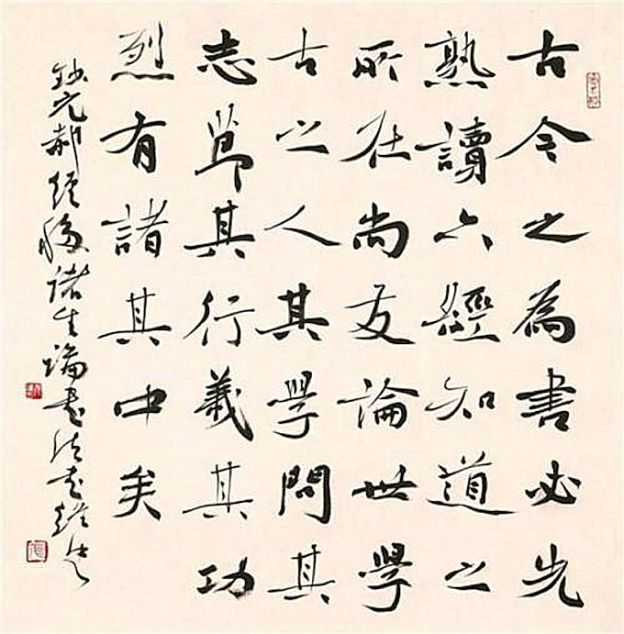
Chinese language evolution, a short article that explains the characteristics of this ancient language, dialects, grammar, phonetics, linguistic and cultural habits
Chinese language tends to be quick, economical. To know what people are saying, you always need to know what the context is.
Gish Jen
The great Chinese literary texts (the so-called Classics, often attributed to Confucius) go back to the sixth century B.C. Lao-tze, the founder of Taoism, is said to have written one century earlier, and Mencius one century later. This chronology places the golden era of Chinese literature and philosophy at approximately the same period as that of Greek, giving the east and the west an equal share in the founding of the great modern civilizations.
Mario Pei
The oldest cook-book of which we have a record is a Chinese one that goes back some 4,700 years. It was compiled by the Emperor Shen Nung, and elaborated by three great Cantonese chefs.
Mario Pei
A person of high principles is one who can watch an entire chess game without making a comment.
Chinese Proverb
One more good man on earth is better than an extra angel in heaven.
Chinese Proverb
It is the most widely spoken language in the world, characterized by a singular musicality and an arcane writing system; however, its grammatical structure is extraordinarily simple. In several respects, indeed, it can be said that Chinese is simpler than Western languages.
Its history and structure it is radically different from the languages of Europe, but these differences can help us to better understand the nature of human language. Thinking no doubt of this structural simplicity, the American linguist and anthropologist Edward Sapir gratified the Chinese as a language “logical in conciseness”.
Contrary to popular belief, the Chinese today no longer bow when greeting each other. Even the handshake is not part of their habits and is reserved only when you meet a Westerner; the greeting that will accompany you is ni hao.
The use of pleasantries is however limited to meetings between Chinese and foreigners. Unlike us Westerners, who traditionally question each other’s state of health, the Chinese ask themselves questions of another kind, such as: Have you eaten? Where are you going? Of all the forms of farewell, the most used is zàijiàn, which corresponds to the Italian goodbye. Another very common formula, with the meaning of goodbye is, mànmàn zou, literally, go slowly.
Compared to us Westerners, the Chinese make a far more limited use of thanks. You thank a friend for an invitation or for help received, but not insistently, otherwise you risk offending him because excessive formality is understood as an attitude of snobbery. In the same way, we do not thank the waiter of a restaurant, nor the clerk of a shop: these are professionals who serve us as a profession and not out of courtesy, thanking them would be understood as a disavowal of their professionalism.
Chinese Language is the language of the Han Chinese people, the majority ethnic group of China. It is the official language of China and one of the official languages of Singapore. Of China’s more than 1 billion people, approximately 95 percent speak Chinese, as opposed to the non-Chinese languages, such as Tibetan, Mongolian, Lolo, Miao, and Tai, spoken by minorities. Chinese is also spoken by large emigrant communities, such as those in Southeast Asia, North and South America, and the Hawaiian Islands. More people speak Chinese than any other language in the world.
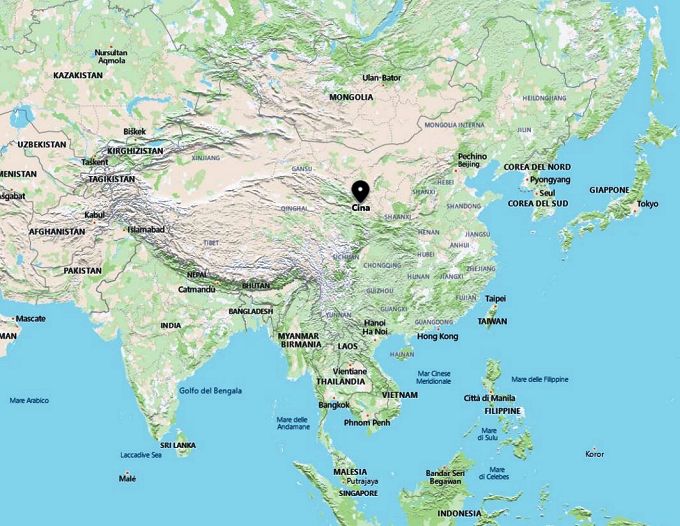
As the dominant language of East Asia, Chinese has greatly influenced the writing systems and vocabularies of neighboring languages not related to it by origin, such as the Japanese language, the Korean language, and the Vietnamese language. It has been estimated that until the 18th century more than half of the world’s printed books were in Chinese.
Chinese, together with Tibetan, Burmese, and many other languages of South and Southeast Asia—belongs to the family of Sino-Tibetan languages. Besides a core vocabulary and sounds, Chinese and many related languages share features that distinguish them from most Western languages: They have even less inflection than the English language and are tonal. In order to indicate differences in meaning between words similar in sound, tonal languages assign to words a distinctive relative pitch, high or low, or a distinctive pitch contour, level, rising, or falling.
Spoken Chinese comprises many regional variants, called dialects. Although they employ a common written form, they are mutually unintelligible, and for this reason controversy exists over whether they can legitimately be called dialects or whether they should be classified as separate languages. The differences among them are analogous to the differences in pronunciation and vocabulary among the Romance languages. Generally, however, the variants of Chinese are referred to as dialects.
Most Chinese speak one of the Mandarin dialects, which are largely mutually intelligible. The dialect spoken in Beijing constitutes the base for standard Mandarin dialect. It forms the basis both of the modern written vernacular, Baihua, which supplanted classical Chinese in the schools after 1917, and of the official spoken language, Putonghua, prescribed in 1956 for nationwide use in schools.
Chinese also has six other dialect groups, all spoken in China’s southeastern provinces. The Yue dialects, also called Cantonese, are spoken in Hong Kong, most of Guangdong, southern Guangxi Zhuang Autonomous Region, parts of Hainan, and in many overseas settlements. Most of the inhabitants of Hunan use the Xiang dialects, also known as Hunanese. The Min dialects are spoken in most of Fujian, large areas of Taiwan and Hainan, parts of eastern Guangdong and the Leizhou Peninsula, and in areas of Southeast Asia. Most of the people living in Jiangxi and the southeastern corner of Hubei use the Gan dialects.
The majority of the inhabitants of Zhejiang, as well as people living in southern areas of Jiangsu and Anhui, speak the Wu dialects. Some Wu speakers share marginal mutual intelligibility with Mandarin and Gan speakers. The Kejia, or Hakka, dialects are spoken in northeastern Guangdong, southern Jiangxi, southwestern Fujian, and in pockets throughout southeastern China and Southeast Asia.
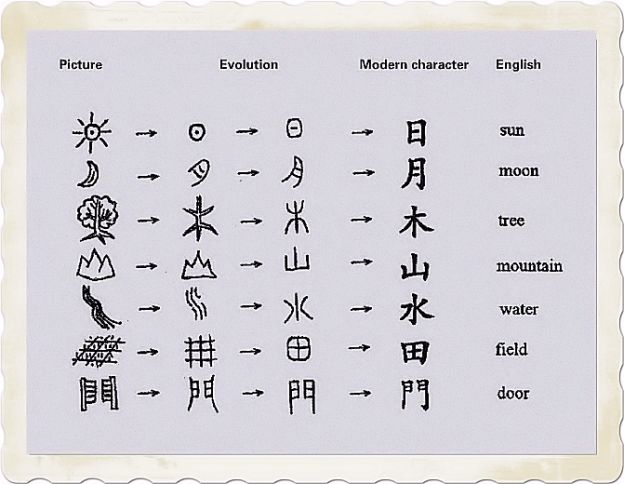
Highly inflected languages such as the Latin language and the Russian language make scores of additions to, or changes in, the sound of a word to indicate grammatical differences. Modern Chinese, on the other hand, never changes, and seldom adds, sounds for such purposes. Because no inflection of nouns exists to show whether they are, for example, subject or object, and no indication is given that verbs, nouns, and adjectives agree with one another in number and case, word order is even more important than it is in English as an indicator of the relation of words to one another in the sentence.
In broad outline, Chinese word order is quite like that of English: subject-verb-object, modifier-modified. On closer inspection, however, the grammar reveals greater differences between the languages. In English every sentence must have a subject, but in Chinese a subject is not an obligatory element. For example, in the English sentence “It rains,” the pronoun it serves as the subject. In Chinese the equivalent might be “xia yu” (fall rain), which does not require a subject.
In general, verb tense is not expressed in Chinese either. Instead, Chinese verbs can have suffixes that express different aspects, such as perfective. In the sentence “Ta chi-le yi-wan fan” (“He has eaten a bowl of rice” or “He had eaten a bowl of rice”), the verbal marker “-le” indicates either present or past perfect tense.
The Chinese written language is of an old and conservative type that assigns a single distinctive symbol, or character, to each syllable. Knowledge of 3,000 to 4,000 characters is needed to read newspapers, and a large dictionary contains more than 40,000 characters (arranged according to sound or form). The oldest discovered texts are oracular sayings incised on tortoise shells and cattle scapulae by court diviners of the Shang dynasty beginning in the early 14th century bc; these are the so-called oracle-bone inscriptions. Although the writing system has since been standardized and stylistically altered, its principles and many of its symbols remain fundamentally the same.
Done with a brush, Chinese handwriting developed into an art form in its own right. Calligraphy, artistic handrwriting or lettering, was important in China before the Tang dynasty, which began in 618.
Like other scripts of ancient origin, Chinese is derived from picture writing. It grew into a word-by-word representation of language when it was discovered that words too abstract to be readily pictured could be indicated by their sound rather than their sense. Unlike other scripts, however, Chinese still works pictographically as well as phonetically. Moreover, its sound indications have not been adapted to changes of pronunciation but have remained keyed to the pronunciation of 3,000 years ago. The building blocks of the system are several hundred pictographs for such basic words as man, horse, and axe. In addition, expanded, or compound, pictographs exist. For example, a symbol of this type representing a man carrying grain means “harvest,” and thus “year” (nian).
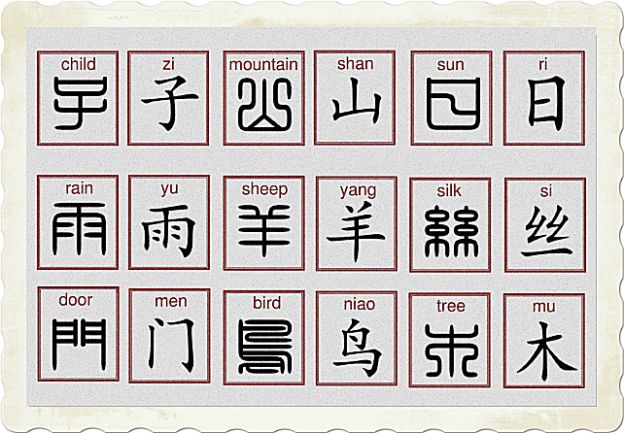
In the Chinese language, each character represents a word, and characters can also be combined to create other words. In the top center newspaper in this photo, the first two characters in the right-hand column mean gold and mountain. During the Gold Rush of 1849, Chinese people referred to California as “Gold Mountain,” and the name is sometimes still applied to the United States in general or to San Francisco in particular.
Phonetic loans are pictographs of concrete words borrowed to indicate abstract words of the same or similar sound. The principle here is that of the rebus, or visual pun. Thus, the pictograph for dustpan (ji) was borrowed for this, his, her, its (qi or ji). Through the Zhou period (11th century to 3rd century bc) many characters had such a dual use. If at that time the scribes had agreed that only the “dustpan” pictograph would stand for any syllable pronounced ji, they would have discovered the principle of the phonetic syllabary, precursor of the alphabet. Because of the great number of homonyms in Chinese, however, scribes instead retreated to picture writing.
The picture of the dustpan came to be used exclusively for his, her, its. In the rarer instances when scribes actually meant to refer to a dustpan, however, they avoided ambiguity by employing a compound symbol in which “dustpan” had added to it the pictograph, or signific, for “bamboo,” representing the material from which dustpans were made. This process for reducing the ambiguity of phonetic loans became in time a process by which any pictograph, borrowed for its sound, could be joined to any other chosen to indicate the meaning, forming a phonetic/signific compound. Thus, “dustpan,” with the addition of an “earth” signific instead of “bamboo,” indicated ji, ”base, foundation.” Today, simple pictographs continue to be used for some of the most basic vocabulary, home, mother, child, rice, fire. Perhaps 95 percent of the words in the dictionary are written with phonetic/signific compounds, however.
To express modern concepts, Chinese generally makes use of equivalents from its native stock of meaningful syllables or renders such terms in phonetic spelling. Thus, chemistry is expressed in Chinese as “study of transformations.”
Qin Shihuangdi (Ch’in Shih-huang-ti), first emperor of a unified China, suppressed many regional scripts and enforced a simplified, standardized writing called the Small Seal. In the Han dynasty (206 bc-ad 220) this developed into the Clerical, Running, Draft, and Standard scripts. Printed Chinese is modeled on the Standard Script. Cursive or rapid writing (the Running and Draft scripts) introduced many abbreviated characters used in artistic calligraphy and in commercial and private correspondence, but it was long banned from official documents. The printing of abbreviated characters is still forbidden in Taiwan but has become the normal practice in the People’s Republic of China and Singapore.
In the English-speaking world, since 1892, Chinese words (except personal and place names) have usually been transliterated according to a phonetic spelling system called Wade-Giles romanization, propounded by British Orientalists Sir Thomas Wade and Herbert Giles. Personal names were romanized according to individual wishes, however, and place names followed the nonsystematic spellings of the Chinese Post Office. Since 1958 another phonetic romanization known as pinyin (spelling) has had official standing in the People’s Republic of China, where it is used for telegrams and in primary education.
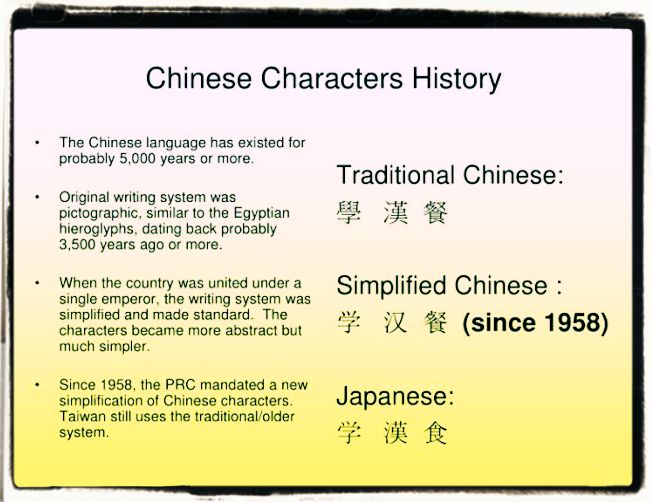
Replacement of the traditional characters by pinyin has been advocated but is unlikely to be carried through completely because of the threat it poses to literature and historical documentation in the classical language. Simplification of the sound system through time, with the resultant homonyms, has made the terse classical style unintelligible when transcribed in an alphabetic script.
Since January 1, 1979, Xinhua (New China News Agency) has used pinyin in all dispatches to foreign countries. The United States government, many scholarly publications, and newspapers such as the New York Times have also adopted the pinyin system, as has this encyclopedia.
The modern Chinese dialects (from the 11th century ad) evolved from Old, or Archaic, Chinese (8th century to 3rd century bc), the sounds of which have been tentatively reconstructed. Although monosyllabic, Old Chinese was not wholly uninflected. The next stage of Chinese that has been carefully analyzed was Middle, or Ancient, Chinese (to about the 11th century ad).
By this time the rich sound system of Old Chinese had progressed far toward the extreme simplification seen in the modern dialects. For instance, Old Chinese possessed series of consonants such as p, ph, b, bh (where h stands for aspiration or rough breathing). In Middle Chinese this had become p, ph, bh; in Mandarin only p and ph (now spelled b and p) are left.
The modern Mandarin syllable consists, at the least, of a so-called final element, namely, a vowel (a, e) or semivowel (i, u) or some combination of these (a diphthong or triphthong), with a tone (level, rising, dipping, or falling) and sometimes a final consonant (an n, ng, or r). Old Chinese, however, had in addition a final p, t, k, b, d, g, and m. The final element may be preceded by an initial consonant but never by a consonant cluster; Old Chinese probably had clusters, as at the beginning of klam and glam.
As sonic distinctions became fewer, for example, as final n absorbed final m, so that syllables such as lam and lan became simply lan, the number of Mandarin syllables different from one another in sound fell to about 1,300. No fewer words existed, but more words were homonyms. Thus, the words for poetry, bestow, moist, lose, corpse, and louse had all been pronounced differently from one another in Middle Chinese; in Mandarin they all become shi in the level tone.
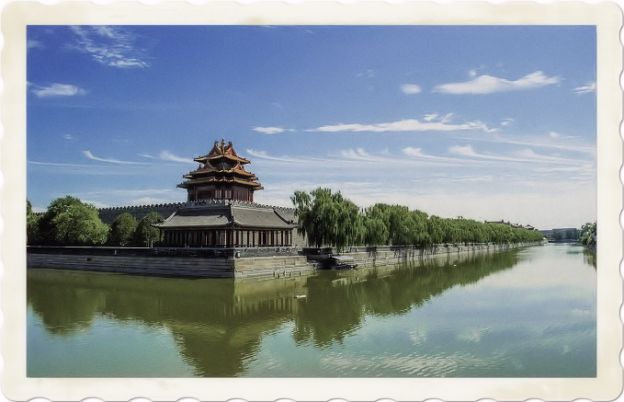
In fact, so many homonyms came to exist that ambiguity would have become intolerable if compound words had not been simultaneously developed. Thus, poetry became shi-ge (poetry-song), and teacher became lao-shi (old-teacher). Although a modern Chinese dictionary contains many more such compounds than one-syllable expressions, most of the compounds still break down into independently meaningful syllables.
If you want to learn more visit the following links and download useful material:


